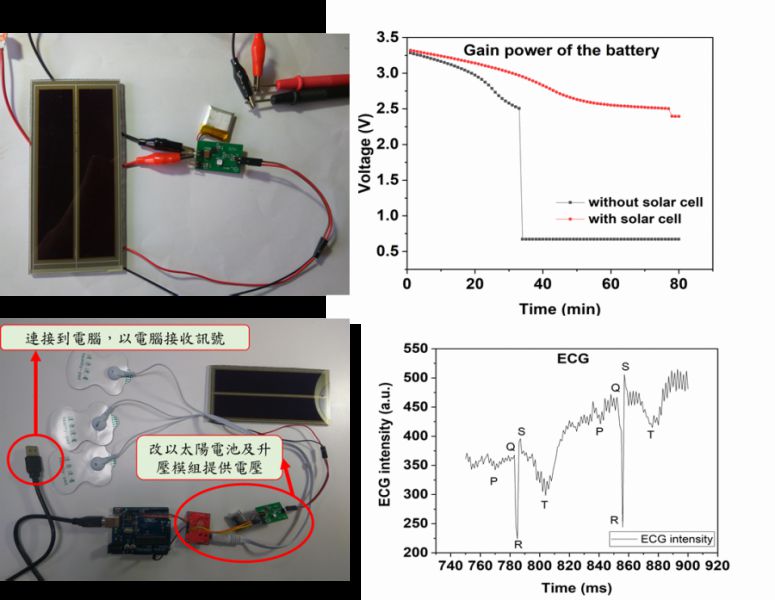生物與化學感測元件研究:
This project aimed to study self-calibrated device and portable heavy metals ions detection system for the detection of water quality in agricultural and aquacultural applications. The self-calibrated device consists of a jig, used for the combination of pH sensors and a microfluidic channel, a MCU controller equipped by a WiFi module, and a remote-controlled syringe pump, driving standard solution for sensor calibration. The self-calibrated device can perform smart sensing and obtain the accurate water qualities.
Furthermore, compared to large and heavy heavy metal detector, a compact and portable heavy metal ions detection system was developed using a portable electrochemical potentiostat and disposable gold electrodes. The heavy metal analyzer is able to determine trace level of lead and zinc ions in tap water. Square wave anodic stripping voltammetry (SWASV) was applied to characterize the real time heavy metal analyzer. First, lead and zinc ions were deposited onto the surface of disposable electrodes by applying the reduction potentials and then deposited zinc were stripped through a square wave potential sweep. In the electrolyte with 1 mM HCl and 0.5 M NaCl, reduction potentials for lead and zinc ion were used to deposit lead and zinc on disposable gold electrodes. After resting time 15 sec, the oxidation currents were used to quantify lead and zinc in the water. These technology will be used to monitor water quality in aquaculture and irrigation.
低功率無線傳輸與系統整合:
This project focuses on real-time sensing and monitoring. We consider the design of software, hardware, and platform architecture, including sensor nodes, actuators, wireless smart gateways, servers, and service implementation. On the basis of the proposed system, network operations and core applications can be effectively achieved.
自主發電材料與儲能設備的開發研究:
We focus on design a compact ultra-low voltage up-converter circuits with rechargeable battery, used in light-driven cell to generate enough energy. This energy conversion system can be applied to ultrasounic and ECG systems.
We use commonly available silicon and dye-sensitized cell as energy inputs. In the indoor light condition, light intensity 2500 lux ~ 6000 lux, the output voltage of silicon cell is about 0.31 V ~ 0.34 V, and the conversion efficiency is about 7.89% ~ 8.82%. The output voltage of the dye-sensitized cell is 0.49 V ~ 0.57 V, and the conversion efficiency is 13.12% ~ 15.34% at the same condition. It is confirmed that the voltage and conversion efficiency of the dye-sensitized cell are better in a dim-light environment. Therefore, the dye-sensitized cell is used as the input in the following works.
Based on the data of the dye-sensitized cell, a compact up-conversion module was designed including DC-DC conversion, energy storage, and maximum power point tracking functions. The area is 6.4 cm2, about the size of a quarter dollar. In the energy supply experiment, the 60 mW LED lamp was used as the output terminal to continuously discharge. With the dye-sensitized cell and the energy conversion module installed, the operation time for the LED lamp extended from 34 minutes to 75 minutes. After the battery is completely discharged, the output energy of the dye-sensitized cell and the energy conversion module is enough to supply the LED to continue lighting. Therefore, it is proved that this module has a continuous power supply capability.
This system is also proved can operate a small ECG module, and the reading by a computerindicate the ECG system operated correctly.
This project aimed to study self-calibrated device and portable heavy metals ions detection system for the detection of water quality in agricultural and aquacultural applications. The self-calibrated device consists of a jig, used for the combination of pH sensors and a microfluidic channel, a MCU controller equipped by a WiFi module, and a remote-controlled syringe pump, driving standard solution for sensor calibration. The self-calibrated device can perform smart sensing and obtain the accurate water qualities.
Furthermore, compared to large and heavy heavy metal detector, a compact and portable heavy metal ions detection system was developed using a portable electrochemical potentiostat and disposable gold electrodes. The heavy metal analyzer is able to determine trace level of lead and zinc ions in tap water. Square wave anodic stripping voltammetry (SWASV) was applied to characterize the real time heavy metal analyzer. First, lead and zinc ions were deposited onto the surface of disposable electrodes by applying the reduction potentials and then deposited zinc were stripped through a square wave potential sweep. In the electrolyte with 1 mM HCl and 0.5 M NaCl, reduction potentials for lead and zinc ion were used to deposit lead and zinc on disposable gold electrodes. After resting time 15 sec, the oxidation currents were used to quantify lead and zinc in the water. These technology will be used to monitor water quality in aquaculture and irrigation.
低功率無線傳輸與系統整合:
This project focuses on real-time sensing and monitoring. We consider the design of software, hardware, and platform architecture, including sensor nodes, actuators, wireless smart gateways, servers, and service implementation. On the basis of the proposed system, network operations and core applications can be effectively achieved.
自主發電材料與儲能設備的開發研究:
We focus on design a compact ultra-low voltage up-converter circuits with rechargeable battery, used in light-driven cell to generate enough energy. This energy conversion system can be applied to ultrasounic and ECG systems.
We use commonly available silicon and dye-sensitized cell as energy inputs. In the indoor light condition, light intensity 2500 lux ~ 6000 lux, the output voltage of silicon cell is about 0.31 V ~ 0.34 V, and the conversion efficiency is about 7.89% ~ 8.82%. The output voltage of the dye-sensitized cell is 0.49 V ~ 0.57 V, and the conversion efficiency is 13.12% ~ 15.34% at the same condition. It is confirmed that the voltage and conversion efficiency of the dye-sensitized cell are better in a dim-light environment. Therefore, the dye-sensitized cell is used as the input in the following works.
Based on the data of the dye-sensitized cell, a compact up-conversion module was designed including DC-DC conversion, energy storage, and maximum power point tracking functions. The area is 6.4 cm2, about the size of a quarter dollar. In the energy supply experiment, the 60 mW LED lamp was used as the output terminal to continuously discharge. With the dye-sensitized cell and the energy conversion module installed, the operation time for the LED lamp extended from 34 minutes to 75 minutes. After the battery is completely discharged, the output energy of the dye-sensitized cell and the energy conversion module is enough to supply the LED to continue lighting. Therefore, it is proved that this module has a continuous power supply capability.
This system is also proved can operate a small ECG module, and the reading by a computerindicate the ECG system operated correctly.




